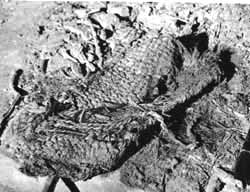
 |
Prehistoric sandal from Salts Cave, Kentucky. (ISM RoI 16, p. 28) | |
|
This sandal was preserved because the cave environment is constantly cool and generally dry, conditions rarely found elsewhere. Caves, and sometimes bogs, are among the few places archaeologists find otherwise perishable objects. |
||
Like Paleo-Indians, during the Archaic Period Native Americans hunted, fished, and gathered wild plant foods such as nuts, but they had a more varied diet than their ancestors. Early Archaic people moved across the landscape when the time was right to take advantage of a particular resource. As time passed during the Archaic Period, people moved from place to place less frequently during the year. As a result, they took greater advantage of the variety of natural foods in the vicinity of their villages. Near the end of the Archaic Period, about 4,000 years ago, Archaic people began to cultivate native plants. This new way of life would change everything from the types of food people ate, to their technology, society, and beliefs, and the way they interacted with their neighbors.
|
|
Copyright © 2000 Illinois State Museum